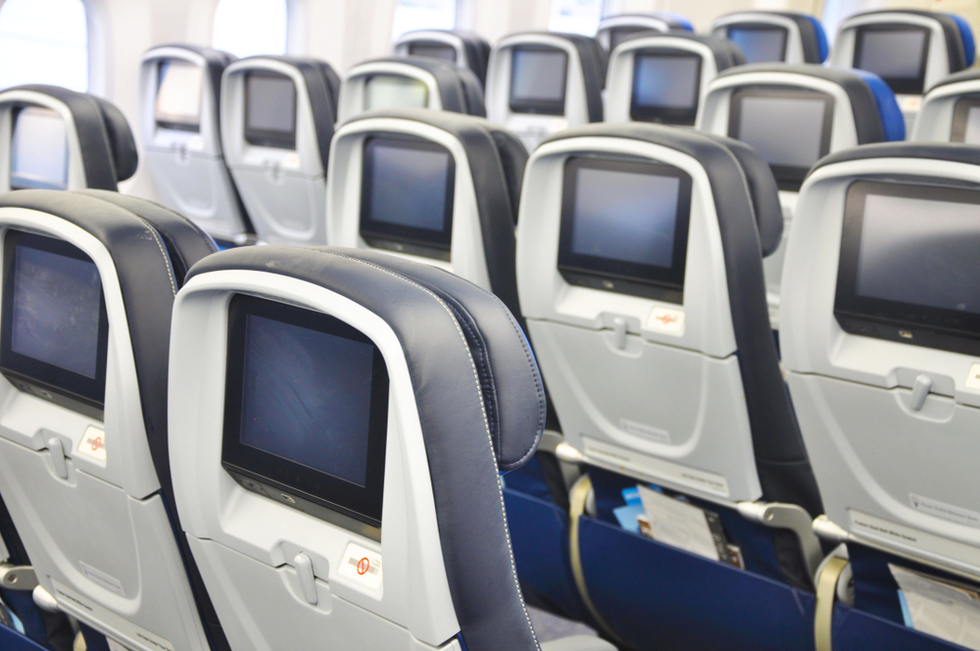Last month United Airlines announced an ambitious, high-tech plan for its on-board passenger experience. By 2032, the airline revealed, more than 800 of its aircraft will be equipped for passengers to connect their Bluetooth headphones to the seatback entertainment systems. Today, only about 100 United jets have that capability.
Made possible by the airline’s biggest influx of new planes ever, the move is a distinct bet on the future of wireless headphone devices—not to mention seatback screens which, just years ago, some industry insiders thought might on the verge of disappearing.
"Instead there are more screens flying worldwide on aircraft than ever before in the history of the world," said Joe Leader, CEO of the Airline Passenger Experience Association (APEX).
This screen “renaissance,” as Leader puts it, is not unique to United. And in many ways, it’s just one aspect of a much larger race by airlines to compete for passengers’ loyalty—and ultimately their money—by infusing new and better technology into the 30,000-foot experience.
An evolution for inflight entertainment
Remember those screens spaced throughout the aircraft, playing one movie for the whole cabin? It’s safe to say we’ve come a long way, though not without hiccups. The airlines have personalized the entertainment options for travelers, to be sure.In its early days, JetBlue made its name by being the first to put live television-equipped screens at every seat. With the rise of tablets and smartphones, plenty of airlines then started offering passengers the opportunity to livestream their library of content on their personal devices….with mixed results, of course, depending on the quality of the streaming connection.
These days, many airlines offer a heftier slate of partnerships with big-name streaming platforms, not to mention other services you might not expect to see in an airplane cabin. American Airlines, for instance, now partners with Apple TV+ and Apple Music. You can stream Showtime or sharpen your language skills with Rosetta Stone while on board.
Delta Air Lines passengers can connect to New York Times games like Wordle, or stream music on Spotify. The airline also has a deal with Paramount Plus which allows flyers to start a show on board and finish it at home, with 24 hours of free access.
For its part, JetBlue recently supplemented its well-known DirecTV service with NBC Universal’s Peacock.
“People are getting to do what they do at home. They’re getting to enjoy the screen in front of them and they’re getting to use their own device as part of their experience,” Leader said.
That’s certainly a plus. So, too, is the fact that many airlines have found ways to make Wi-Fi much more reliable, after years of spotty connections (and "spotty" might be generous), not to mention high prices.
Sure, the connectivity problems aren’t entirely gone, Leader said. And high prices haven’t entirely disappeared; I paid $30 for Wi-Fi on a recent transatlantic flight aboard American Airlines. But more satellites and better technology has fueled marked improvements.“It’s so much more reliable than it’s been in the past," Leader said.
Southwest Airlines has outfitted hundreds of its planes over the last couple of years with higher-bandwidth Wi-Fi equipment as part of a larger $2 billion customer experience-centered plan. The airline charges a flat, $8-per-flight rate for browsing —well below what some carriers have historically offered.
Meanwhile, Delta joined the likes of JetBlue this year in rolling out free Wi-Fi to its planes: 620 aircraft so far and the rest to come by the end of 2024, including the carrier’s smallest regional jets.
“We’re going to have gate-to-gate service, so as soon as that boarding door closes, customers are going to have access to consistent, high-speed Wi-Fi,” Delta managing director of customer experience Ekrem Dimbiloglu said at an industry conference this week. “It’s really giving customers the flexibility, like they would at home, to do what they want.”
Airlines stand to gain, too
Make no mistake, whether it’s free Wi-Fi or a new entertainment partnership, there is a clear business incentive behind all of this.
Delta, for example, requires passengers who wish to access free WiFi to sign up for the airlines’ SkyMiles frequent flyer program. The move has helped drive record loyalty program sign-ups this year.
How does that help Delta? Earlier this year, executives shared that an average 1 in 8 new SkyMiles members ultimately opts for a Delta-American Express credit card—a card program from which the company makes billions of dollars annually. Today, many of largest airlines make more money selling miles to banks than they do seats—and the airline co-branded cards are a large part of that equation.
In trying to woo passengers from the larger airlines to its budding slate of European flights, JetBlue regularly points to inflight features like its custom, touchscreen meal ordering capability that’s available even in coach.
For United’s part, its Bluetooth-enabled technology is just one part of a massive brand strategy the airline has dubbed “United Next,” which will see the airline take delivery of hundreds of new planes that, by the way, will supposedly offer enough overhead bin space for every passenger’s rollaboard bag, says the airline.
Still, Leader says, the fact that airlines are equipping aircraft with new technological bells and whistles is ultimately a win for travelers. Expect to see more in the future, he said, from more of these partnerships and 'personalized' apps on board, to lighter, thinner entertainment screens onto which you may be able to cast media from your phone some day.
"It’s really nice to see the future travel experience developing at such a good clip. That airlines are recognizing it’s not all about them," Leader said. "It’s about their customers and the journey."







